Treating Transport as a Science
Page 35
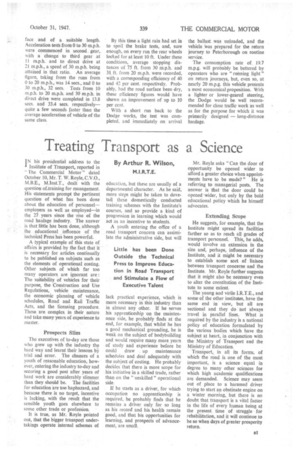
Page 36
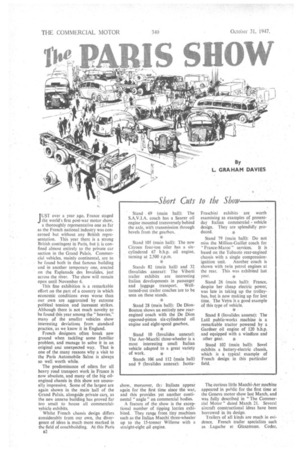
Page 37

Page 38
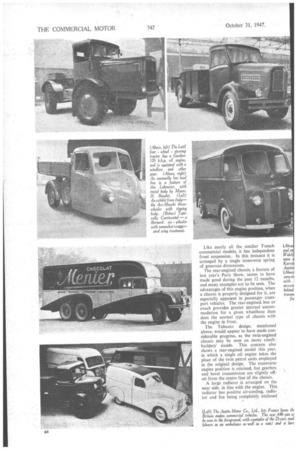
Page 39
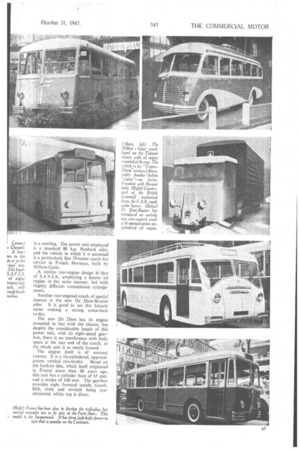
Page 40
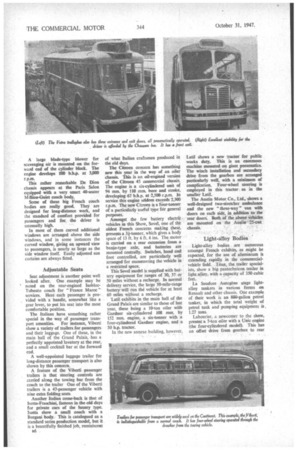
Page 43
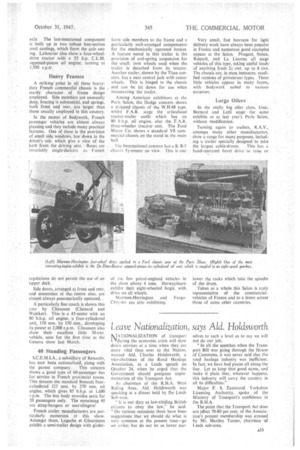
If you've noticed an error in this article please click here to report it so we can fix it.
By Arthur R. Wilson,
M.I.R.T.E. IN his presidential address to the I Institute of Transport, reported in The Commercial Motor" dated October 10, Mr. T. W. Royle, C.V.O., M.B.E., M.Inst.T., dealt with the question of.training for management. His statements prompt the pertinent question of what has been done about the education of personnel— employers as well as employed—in the 27 years since the rise of the road haulage industry. The answer is that little has been done, although the educational influence of the technical Press has been powerful.
A typical example of this state of affairs is provided by the fact that it is necessary for articles continually to be published on subjects such as the elements of operational costing. Other subjects of which far too many operators are ignorant are : The suitability of vehicles for their purpose, the Construction and Use Regulations, vehicle maintenance, the economic planning of vehicle schedules, Road and Rail Traffic Acts, and the licensing procedure. These are complex in their nature and take many years of experience to master.
Prospects Slim The executives of to-day are those who grew up with the industry the hard way and learnt their lessons by trial and error_ The chances of a youth of reasonable education, however, entering the industry to-day and securing a good post after years of hard work are considerably slimmer than they should be. The facilities for education are too haphazard, and because there is no target, incentive is lacking, with the result that the sensible youth goes elsewhere to some other trade or profession.
It is true, as Mr. Royle pointed out, that the bigger transport undertakings operate internal schemes of education, but these are usually of a departmental character. As he said, more steps might be taken to dovetail these domestically conducted training schemes with the Institute's courses, and so provide a kind of progression in learning which would act as an incentive to students.
A youth entering the office of a road transport concern can assimilate the administrative side, but will lack practical experience, which is more necessary in this industry than in almost any other. If he serves his apprenticeship on the maintenance side, he probably finds at the end, for example, that whilst he has a good mechanical grounding, he is weak on the subject of bodybuilding and would require many more years of study and experience before he could draw •, up maintenance schedules and deal adequately with the subject of costing. He probably decides that there is more scope for his initiative in a skilled trade, rather than on the " unskilled " operational side.
If he starts as a driver, for which occupation no apprenticeship is required, he probably finds that he remains a driver only for so long as his record and his health remain good, and that his opportunities for learning, and prospects of advancement, are small. Mr. Royle asks "Can the door of opportunity be opened wider to afford a greater choice when appointments have to be made?" He is referring to managerial posts. The answer is that the door could be opened wider, but only by the bold educational policy which he himself advocates.
Extending Scope He suggests, for example, that the Institute might spread its facilities farther so as to reach all grades of transport personnel This, he adds, would involve an extension in the size and, perhaps, influence of the Institute, and it might be necessary to establish some sort of liaison between transport concerns and the Institute. Mr. Royle further suggests that it might also be necessary even to alter the constitution of the Institute to some extent.
The young and virile I.R.T.E., and some of the other institutes, have the same end in view, but all are sectional and they do not always travel in parallel fines. What is required by the industry is a national policy of education formulated by the various bodies which have the subject at heart, in conjunction with the Ministry of Transport and the Ministry of Education.
Transport, in all its forms, of which the road is one of the most important, is a science equal in degree to many other sciences for which high academic qualifications are demanded. Science may seem out of place to a harassed driver trying to start an obstinate engine on a winter morning, but there is no doubt that transport is a vital factor in the life of every human being at the present time of struggle for rehabilitation, and it will continue to be so when days of greater prosperity return. TUST over a year ago, France staged J the world's first post-war motor show,
a thoroughly representative one as far as the French national industry was concerned but without any British representation. This year there is a strong British contingent in Paris, but it is confined almost entirely to the private car section in the Grand Palais. Commer, cial vehicles, mainly continental, are to be found both in that famous building and in another temporary one, erected on the Esplanade des Invalides, just across the river. The show will remain open until November 6.
This fine exhibition is a remarkable effort on the part of a country in which economic conditions even worse than our own are aggravated by extreme political tension and incessant strikes. Although there is not much novelty to be found this year among the " heavies," many of the smaller vehicles show interesting deviations from standard practice, as we know it in England.
French designers often break new ground when tackling. some familiar problem, and manage to solve it in an original anci unexpected way. That is one of the many reasons why a visit to the Paris Automobile Salon is always so well worth while.
The predominance of oilers for all heavy road transport Work in France is now absolute, and many of the big oilengined chassis in this show are unusually. impressive. Some of the largest are again shown in the main hall of the Grand Palais, alongside private cars, as the new annexe building has proved far too small to house all commercialvehicle exhibits.
Whilst French chassis design differs considerably Isom our own, the divergence of ideas is much more marked in the field of coachbuilding. At this Paris n2 show,, moreover, th:., Italians appear again for the first time since the war, and this provides yet another continental " angle" on commercial bodies.
A feature of the show is the exceptional number of tipping lorries exhibited. They range from tiny machines such as the Italian Macchi three-wheeler up to the 15-tonner Willerne with a straight-eight oil engine.
The curious tittle Macchi-Aer machine appeared in public for the first time at the Geneva motor show last March, and was fully described in "The Commercial Motor" dated March 21. Several aircraft constructional ideas have been borrowed in its design, Trailersof all kinds are much in evidence. French trailer specialists such as ,Lagache et Glaszmann, Coder, R.A.Y., Titan, Genive, and others have interesting exhibits, some of which embody original ideas.
Certain French prototypes seen at the 1946 Salon appear to have been considerably developed during the past 12 months, one example being the rearemitted Tubauto chassis, in which two engines are mounted transversely and operate as a unit, with a bevel drive and gearbox between them. Another is the excellent little Chenard-Wakker short-wheelbase vehicle, with a 25 h.p. petrol engine. This appears in a great variety of adaptations. It has a twin two-stroke power unit.
Electric vehicles are relatively few, a fact which is rather surprising, in view of the stimulus given to their development in France during the past seven or eight years, by a complete lack of liquid fuels during enemy occupation, plus the shortage and high cost of such fuels since the war ended. Soya!, ltdlildeKrieger and Vetra show battery-electric vehicles, Vetra, in addition, staging a good example of single-decker trolleybus. Jaequemont, of Lyons, also show a smaller trolleybus.
Amongst really big, heavy-duty oilers, Willeme, Bernard, &surer, and 1.atil show fine examples of French roadvehicle engineering at its best Some of these French heavy-vehicle concerns have adopted a very useful system of normalizatitm. In the Willerne range, for instance, their four-, six-, and eightcylindered oil engines all have identical main components. The bore and stroke of every engine are of the same dimen sions, and all units are designed to develop their power at the same normal speed of 1,600 r.p.m.
A point noted in most of the larger French chassis is the employment of secondary helper springs for the rear axle and Michelin-Bibax rubber mounting of rear wheels, with rubber-bonded security bolts.
The nationalized Renault concern has increased its commercial-vehicle range for 1948 by the inclusion of a very smart little 3i-cwt. delivery van on a modified version of the pre-war Javarmatre chassis. It shows also a new 2-tonner. This has a taw load-line and an advanced position for the driver's cab, with a corresponding increase in body capacity. Renault also shows its 20-cwt. chassis and 7-ton oiler.
La -Licorne, specialists in small commercial chassis for many years, present a new one-tonner. This is a neat little job on classic French lines, with a fourcylindered engine of 1,450 cc., turning at 3,500 r.p.m. Maximum speed under full load is 45 m.p.h. Like nearly all the smaller French commercial models, it has independent front suspension. In this instance it is arranged by a single transverse spring of generous dimensions.
The rear-engined chassis, a feature of last year's Paris Show, seems to have made good during the past 12 months, and many examples are to be seen. The advantages of this engine position, when a chassis is properly designed for it, are especially apparent in passenger transport vehicles. The rear-engined, bus or coach provides greater internal accommodation for a given wheelbase than does the normal type of chassis with the engine in front.
The Tubauto design; mentioned above, would appear to have made considerable progress, as the twin-engined chassis may be seen on many coachbuilders' stands. This concern also shows a rear-engined model this year, in which a 'single oil engine takes the place of the twin petrol units employed in the original design. The transverse engine position is retained, but gearbox and bevel transmission are slightly offset from the centre line of the chassis.
A large radiator is arranged on the near side, in line with the engine. This radiator has positive air-cooling, radiator and fan being completely enclosed in a cowling. The power unit employed is a standard 80 h.p. Panhard oiler, and the vehicle in which it is mounted is a particularly fine 39-seater coach for service in French Morocco, built by M illion-Guiet.
A similar rear-engine design 1s:that of S.A.V.I.A., employing a Saurer oil engine in the same manner, but with slightly different transmission airange . , ments.
Another rear-engined coach of special. interest is the new De Dion-Bouto'n oiler. It is good to see this histaric name making a strong come-back to-day.
The new De Dion has its engine mounted in line with the chassis, but despite the considerable length of this power unit, with its eight-speed gearbox, there is no interference with body space at the rear end of the coach, as the whole unit is so neatly housed.
The engine itself is of unusual interest. It is a six-cylindered, opposed piston, vertical two-stroke. Based on the Junkers idea, which itself originated in France more than 40 years ago, this unit has a cylinder bore of 65 mm. and a stroke of 140 mm. The gearbox provides eight forward speeds. fourth, fifth, sixth and seventh being synchronized, whilst top is direct. A large blade-type blower for scavenging air is mounted on the forward end of the cylinder block. The engine develops 100 b.h.p. at 3,000 r. p.m.
This rather remarkable De Dion chassis appears at the Paris Salon equipped with a very smart 40-seater Million-Guiet coach body.
Some of these big French coach bodies are really good. They are designed for long-distance work, and the standard of comfort provided for passengers and for the driver is unusually high.
In most of them curved additional windows are arranged above the side windows, and in some instances the curved window, giving an upward view to passengers, is nearly as large as the side window itself. Easily adjusted sun curtains are always fitted.
Adjustable Seats
Seat adjustment is another point well looked after. One example may be noted on the rear-engined IsoblocTubauto coach for "France Maroc" services. Here each passenger is provided with a handle, somewhat like a gear lever, to put his seat into the most comfortable position. "
The Italians have something rather special in the way of passenger trans port amenities. For instance, Viberti show a variety of trailers for passengers and their luggage. One of these, in the main hall of the Grand Palais, •hasa perfectly appointed lavatory at the rear, and a small cocktail bar at the forward end.
A well-appointed luggage trailer for long-distance passenger transport is also shown by this concern.
A feature of the Viberti passenger trailers is that steering controls are carried along the towing bar from the coach to the trailer One of the Viberti trailers is a 47-passenger vehicle with nine extra folding seats.
Another Italian come-back is that of Isotta-Fraschini, famous in the old days for private cars of the luxury type. Isotta show a small coach with a Borgani body. This is catalogued as a standard series production model, but it is a beautifully finished job, reminiscent of what Italian craftsmen produced in the old days.
The Citroen concern has something new this year in the way of an oiler chassis. This is an oil-engined version of the Citroen 45 commercial chassis. The engine is a six-cylindered unit of 94 mm. by 110 mm. bore and stroke, developing 67 b.h.p. at 2,500 r.p.m. In service this engine seldom exceeds 2.300 r.p.m. The new Citroen is a four-ton tier of a particularly useful type for general purposes.
Amongst the few battery electric vehicles in this Show. Sovel, one of the oldest French concerns making these, presents a 31-tonner, which gives a body space of 13 ft. by 6 ft. 6 ins. The motor is carried on a rear extension from a banjo-type axle, and batteries are mounted centrally. Switches, hand and foot controlled, are particularly well arranged for manceuvring the vehicle in a restricted space.
This Sovel model is supplied with battery equipment for ranges of 30, 37 or 50 miles without a recharge. In normal delivery service, the large 50-mile-range battery will run the vehicle for at least 60 miles without a recharge.
'Latil exhibits in the main hall of the Grand Palais are similar to those of last year, these being a 10-ton oiler with Gardner six-cylindered 108 mm. by 152 mm. engine, a six-tonner with a four-calindered Gardner engine, and a 53 h.p. tractor.
In the new annexe building, however. Latil shows a new tractor for public works duty. This is an enormous machine mounted on giant pneumatics. The winch installation and secondary drive from the gearbox are arranged particularly well, with a minimum of complication. Four-wheel steering is employed in this tractor as in the smaller Latil.
The Austin Motor Co.. Ltd,. shows a well-designed two-stretcher ambulance and the new " three-way " van with doors on each side, in addition to the • rear doors. Both of the above vehiCle; are mounted on the Austift-'25-caat chassis.
Light-alloy Bodies
Light-alloy bodies arc numerous amongst French exhibits, as might be expected, for the use of aluminium is extending rapidly in the commercialvehicle field. Titan, the trailer special. ists, show a big pantechnicon trailer in light alloy, with a capacity of 350 cubic feet. •
La Soudure Autogene stage lightalloy tankers in various farms on Renault and other chassis. One example of their work is an 880-gallon petrol tanker, in which the total weight of petrol tank and pumping equipment is. 1.27 tons.
Labourier, a newcomer to the show, present a 7-toa oiler with a Unic engine the four-cylindered model). This has an offset drive from gearbox to rear
axle The • last-inentioned component is built up in two robust box-section steel castings, which form the axle casing. Labourier also show a four-wheeldrive tractor with a 55 h.p. C.L.M. opposed-piston oil engine, turning at 1,500. Liam% Heavy Frames
A striking point in all these heavyduty French commercial chassis is the sturdy character of frame design employed. Side members are unusually deep, bracing is substantial, and springs, both front and rear, are larger than those usually employed in this country,
In the matter of bodywork, French passenger vehicles are almost always pleasing and they include many practical features. One of these is the provision of small side windows, low down in the driver's cab, which give a view of the kerb from the driving seat. Buses are invariably single-deckers as French
regulations do not permit the use of an upper deck.
Side doors, arranged at front and rear, and sometimes at the. centre also, are almost always pneumatically operated, A' particularly fine coach is shown this ,.ear by Chausson (Chenard and Walcker). This is a 45-seater with an 80 b.h.p. oil engine, a four-cylindered unit, 110 mm. by 150 mm., developing its power at 2,000 r.p.m. Chausson also show their excellent little 30-cwt. vehicle, seen for the first time at the Geneva show last March.
40 Standing Passengers
S.C.E.M.I.A., a subsidiary of Renaults, has now been nationalized, along with the parent company. This concern shows a good type of 60-passenger bus for service in French provincial towns. This mounts the standard Renault fourcylindered 125 mm. by 270 mm, oil engine, which gives 85 b.h.p. at 1,600 r.p.m. The bus body nrovides seats for 20 passengers only. The remaining 40 are strap-hangers or seat-clingers!
French trailer manufacturers are particularly numerous at this show. Amongst them, Lagache et Glasztriann exhibit a semi-trailer design with girder torm side members to the frame and a. particularly 'well-arranged compensator for the mechanically operated brakes. A feature noted in this trailer is the provision of coil-spring suspension for the small, twin wheels used when the trailer is detached from its tractor. Another trailer, shown by the Titan concern. has a neat central jack with castor wheels. This is hinged to the chassis and cart be let &mil for use when manoeuvring the trailer.
Among American exhibitors at the Paris Salon, the Dodge concern shows a stripped chassis of the W.H.48 type. whilst F.A.R. stage the articulated tractor-trailer outfit which has an 80 b.h.p. oil engine, also the F.A.R. three-wheeler tractive unit. The Ford Motor Co. shows a standard V8 commercial chassis on the stand in the main hall.
The International concern has a K B-5 Ctinssis 56-tanner on view.. This is One
of the few petrol-engined vehicles in the show above 4 tons. Herwaythorn exhibit their eight-wheeled bogie, with. drive on all wheels.
Marmon-Herrington and FargoChrysler are also exhibiting. Very small, fast boxyans for light delivery work have always been popular in France and numerous good examples appear at the Salon. Peugeot, Simca, Renault, and La Licorne all stage vehicles of this type, taking useful loads of anything from cwt. up to 8 cwt. The chassis are, in most instances, modified versions of private-car types. These little vehicles appear in many forms, with bodywork suited to various purposes.
Large Oilers In the really big oiler class, Unic. Bernard and Latil stage the , same exhibits as at last year's Paris. Salon, without modification.
Turning again to trailers, R.A.V., amongst many other manufacturers, show, a range for many purposes, including a trailer specially designed to take the largest cable-drums. This has a hand-operated bevel .drive to raise or
lower the racks which take the spindle of the drum.
Taken as a whole this Salon is truly representative of the commercialvehicles of France and to a lesser extent those of some other countries.












































































